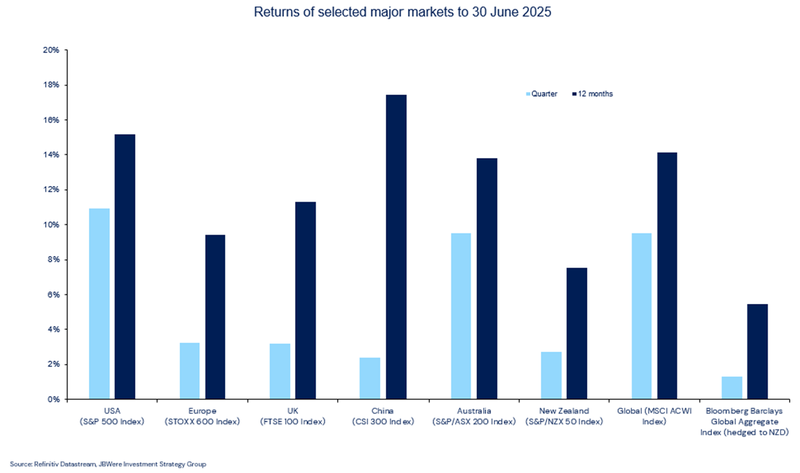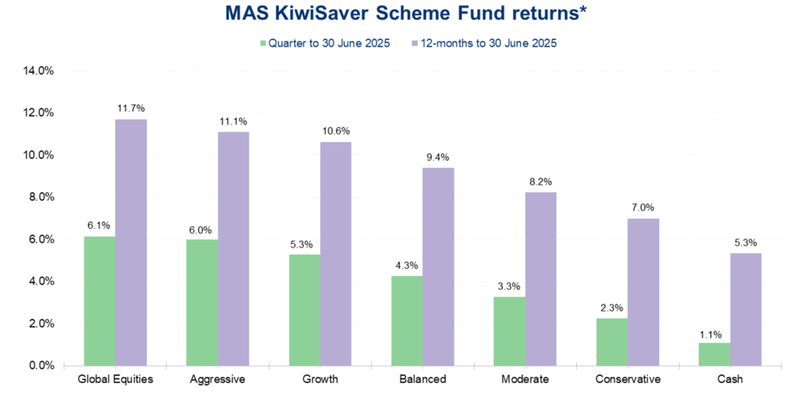21 July 2025
Key takeaways:
- The early April sell-off following the US ‘Liberation Day’ tariff announcement was brief, with share markets rebounding strongly.
- The global share market1 ended the June quarter up 9.5% (all returns are in local currency unless otherwise stated).
- Fixed interest markets also provided solid returns over the quarter.
- Investors were largely unfazed by the escalating tension in the Middle East.
Below is an in-depth review of financial markets over the June quarter.
Global share markets delivered a robust performance in the June quarter, overcoming tariff uncertainty, geopolitical tensions and US fiscal worries. Rebounding from its early April lows, the global share market posted a 9.5% quarterly gain (all returns are in local currency terms unless stated). The US share market2 led the rally, finishing up 10.9%, and closing June on a new record high. While tension in the Middle East saw a brief spike in the price of oil, investors were largely unfazed by the conflict.
The quarter started on a negative note in April, with the Trump administration announcing its long-awaited ‘reciprocal’ tariff policy. The magnitude and scope of the tariffs were significantly more aggressive than expected. With such an aggressive stance, and the risks it created for global economic growth, it was not surprising to see share markets around the world decline following the announcement. The S&P 500 was one of the hardest hit, tumbling more than 10% in a matter of days.
Rising bond yields, increasing corporate discontent and potentially declining popularity led President Trump to temporarily suspend the more aggressive US tariffs on most countries. Trump announced the suspension to allow negotiations, resulting in a strong rebound from the April lows in share markets around the world.
The US corporate earnings season was robust, with most companies beating earnings estimates, with the technology sector leading the way. They largely delivered strong earnings with positive outlooks, helping to ease concerns around the US’s leadership in AI. This translated into strong performance, with the US information technology sector rallying 23.7% over the quarter, comfortably the strongest performing sector.
Outside of the US, returns were healthy but more subdued over the quarter. The European share market3 gained 3.3%, with the real estate and industrial sectors leading the way. The German share market4 was a particularly strong performer, returning 7.9% over the quarter. This was driven by excitement that a large increase in defence and infrastructure spending, and approval of a corporate tax relief package to support companies, would revive its sluggish economy.
The Chinese economy faced mounting pressures, with declining trade volumes and deflation in the key housing and construction sectors. Supportive stimulus measures, however, saw the Chinese share market5 gain 3.3% over the quarter.
Closer to home, the New Zealand share market6 recorded a modest 2.7% gain. The local economy appears to be stumbling along the bottom, with any recovery continually being pushed out. Given the state of the economy, interest rates are likely to remain lower for longer. Across the Tasman, globally exposed companies drove the Australian share market7 higher, recording its third consecutive monthly gain in June. Over the quarter the S&P/ASX 200 Index recorded a healthy 9.5% gain.
Most fixed income markets delivered positive gains over the quarter. The US was supported by the expectations of potential Federal Reserve interest rate cuts and declining US Treasury yields in June. Eurozone bond yields mostly retreated, reflecting the conservative stance of the European Central Bank, which cut interest rates twice in the quarter. In New Zealand, fixed interest recorded solid gains over the June month and quarter, with the drift lower in interest rates being the main driver.
The differing fortunes of various market indices are illustrated in the chart below.

Note: Returns are in local currency terms.
What this means for our funds over the June quarter
The chart below shows selected returns for all funds in the MAS KiwiSaver Scheme. Returns for comparable funds in the MAS Retirement Savings Scheme and MAS Investment Funds are similar

Note: Returns are after total annual fund charges and before tax.
Key points to note from the chart above
- The June quarter saw positive returns across all MAS funds.
- The outperformance of growth assets (shares) compared to income assets (bonds and cash), meant the more growth orientated funds outperformed the more conservative funds over the quarter.
- Performance has been strong over the past 12-months ending 30 June 2025.
The outlook
It is probably wishful thinking to assume that uncertainty and market volatility will abate in any meaningful way over the second half of 2025. The broader performance of financial markets will continue to be determined by the tension and interaction between underlying macro resilience and what is still a highly uncertain trade, fiscal, monetary and geopolitical policy backdrop. As always, we believe the primary focus should be on whether we need to be preparing for a sustained period of economic weakness, or even recession, in the US and global economies. There are certainly risks, and numerous things our lead investment manager, JBWere, is watching. In particular, the US labour market. But their base case is that economic resilience wins out and the cycle has further to run yet.
With uncertainty elevated, and obvious catalysts evident for further market volatility, the need to maintain good investment and portfolio construction discipline persists. This is certainly the focus within the MAS Schemes, where our active management style allows us to regularly test and adjust conviction levels when deemed necessary. The economic and market landscape is constantly evolving. But through strong diversification and its exposures to high-quality investments, we believe the MAS Schemes are well positioned to weather what could be in store next.
When it comes to investing and thinking about what the future may hold, there is always a so-called ‘wall of worry’. That is, things on the horizon that may pose threats or concerns and potential reasons to delay or avoid taking investment risk. At times this ‘wall’ may appear insurmountably high. What a resilient economic (and corporate fundamental) backdrop allows is for that wall of worry to be scaled more easily, just as we’ve seen so far this year. It certainly won’t be all smooth sailing, but JBWere’s broad expectation is that the second half of the year will see more of the same resilience.
We have useful online tools to help you:
- Our Fund Finder can help you see if you're in the right Fund for your circumstances.
- Our KiwiSaver Retirement Calculator can help you understand if your retirement savings are on track.
- Our MAS Investor Portal can help you manage your investments online.
If you decide to change your Fund after reviewing your risk profile or meeting with a MAS Adviser, you can make a switch via the MAS Investor Portal, or alternatively you can complete an investment strategy change request form. There is no fee for switching. Links to the relevant forms are below.
- MAS KiwiSaver Scheme: KiwiSaver Documents and Forms – MAS
- MAS Retirement Savings Scheme: Retirement Savings Scheme Documents and Forms – MAS
- MAS Investment Funds: Investment Funds Documentations and Forms
You can see weekly updates on fund unit prices and returns on our website.
1 As represented by the MSCI All Country World index.
2 As represented by the S&P 500 index.
3 As represented by the Euro Stoxx 600 Index
4 As represented by the DAX index
5 As represented by the Shanghai Composite index
6 As represented by the S&P/NZX 50 index
7 As represented by the S&P/ASX 200 index
This article is of a general nature and is not a substitute for professional and individually tailored advice. Medical Funds Management Limited, JBWere (NZ) Pty Ltd and Nikko Asset Management New Zealand Limited, their parent companies and associated entities do not guarantee the return of capital or the performance of investment funds. Returns indicated may bear no relation to future performance. The value of investments will fluctuate as the values of underlying assets rise or fall.
MAS is a financial advice provider. Our financial advice disclosure statement is available by visiting mas.co.nz or by calling 0800 800 627.
The Product Disclosure Statement for the MAS KiwiSaver Scheme is available: KiwiSaver – MAS
The Product Disclosure Statement for the MAS Retirement Savings Scheme is available: Retirement Savings Scheme – MAS
The Product Disclosure Statement for the MAS Investment Funds is available: Investment Funds – MAS
Medical Funds Management Limited is the issuer and manager of the Schemes.
